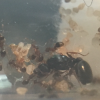Edited by Amazant, September 17 2019 - 3:42 PM.
- Formiculture.com
- Forums
- Gallery
- Members
- Member Map
- Chat

Edited by Amazant, September 17 2019 - 3:42 PM.



Ita likely social parasite queen, not sure what type though, and not sure how she got in.The workers are probably caring for her.
Not a threat to the colony.
I dunno. It's a pretty weird one in a million occurence.
Keep us updated!
Plants r cool
Colonies get large and the majority of workers are stronglygnathus.Pupae may be raided from other colonies. The original colonie is not harmed, and the queen is kept safe.
Quite a rare find, hope she gets to workers.
Edited by Amazant, September 17 2019 - 5:10 PM.
Queen, not sure how it got in, keep it, way more interesting than tetramorium, I meant the full colony of the parasite may raid other tetra colonies.
You can see wings in the first pic though
not on here
This ant is hard to find as well


get a pic of the jaws
0 members, 1 guests, 0 anonymous users